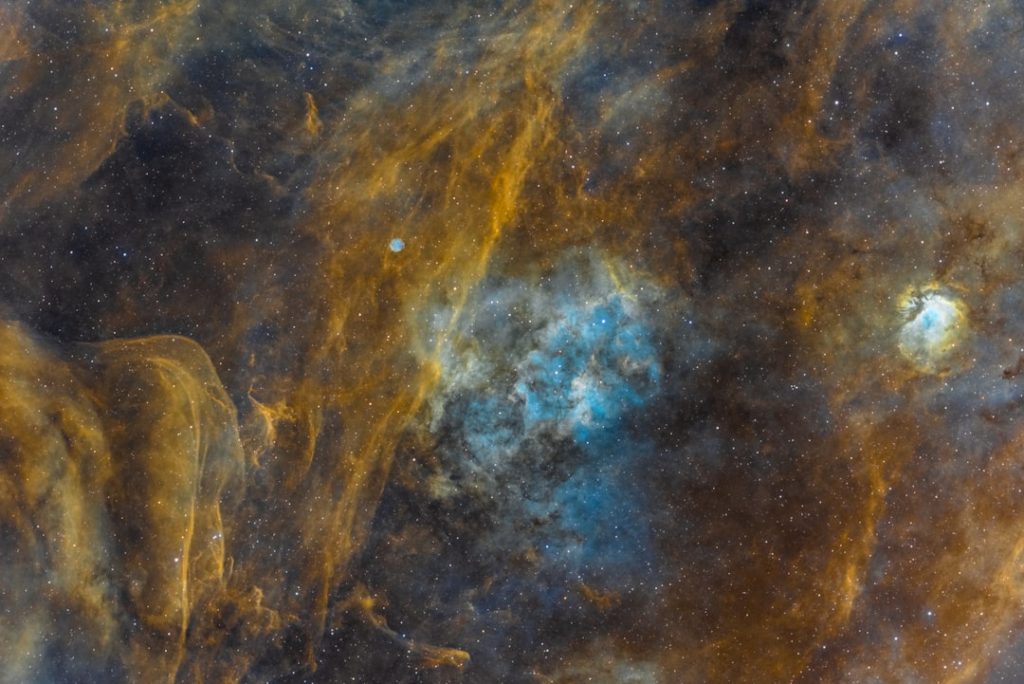Mars, often referred to as the Red Planet, has captivated human imagination for centuries. Its distinct reddish hue, caused by iron oxide or rust on its surface, makes it one of the most recognizable celestial bodies in our night sky. Mars is the fourth planet from the Sun and is approximately half the size of Earth, with a diameter of about 6,779 kilometers.
Its surface features a diverse landscape that includes the largest volcano in the solar system, Olympus Mons, and an extensive canyon system known as Valles Marineris, which dwarfs the Grand Canyon. The planet’s unique characteristics have made it a focal point for scientific research and exploration. Mars has a thin atmosphere composed primarily of carbon dioxide, with traces of nitrogen and argon.
This atmosphere is about 100 times less dense than Earth’s, which contributes to its harsh surface conditions. Temperatures on Mars can vary dramatically, ranging from a balmy 20 degrees Celsius near the equator during the day to a frigid minus 125 degrees Celsius at the poles during winter nights. These extreme conditions, combined with its geological features and potential for past water presence, make Mars a prime candidate for understanding planetary evolution and the potential for life beyond Earth.
Key Takeaways
- Mars is the fourth planet from the sun and is often referred to as the “Red Planet” due to its reddish appearance.
- The geological mysteries of Mars include its massive volcanoes, deep canyons, and dry riverbeds, which suggest a complex and dynamic past.
- Scientists are actively searching for signs of past or present life on Mars, including evidence of water, organic molecules, and potential habitats for microbial life.
- Mars has a thin atmosphere composed mostly of carbon dioxide, and its climate is characterized by extreme temperature variations and frequent dust storms.
- The possibility of human colonization on Mars is being explored through initiatives such as SpaceX’s plans for establishing a sustainable human settlement on the planet.
Uncovering the Geological Mysteries of Mars
The geological history of Mars is a complex tapestry woven from volcanic activity, erosion, and sedimentation processes that have shaped its surface over billions of years. One of the most significant geological features on Mars is Olympus Mons, a shield volcano that rises approximately 22 kilometers high, making it nearly three times taller than Mount Everest. The sheer size of Olympus Mons suggests that it has been active for an extended period, with lava flows that have spread over vast distances.
This raises intriguing questions about the planet’s volcanic history and whether it could still be geologically active today. In addition to its towering volcanoes, Mars is home to an array of impact craters that provide insight into its geological past. The planet’s surface is littered with craters of varying sizes, some dating back billions of years.
These craters serve as a record of the solar system’s history, revealing information about the frequency and scale of impacts that Mars has endured. The study of these craters helps scientists understand not only Mars’ geological evolution but also the broader context of planetary formation and the dynamics of our solar system.
The Search for Signs of Life on Mars

The quest to find signs of life on Mars has been one of the driving forces behind numerous missions to the planet. The presence of water in various forms—ice at the poles, briny liquid water in subsurface lakes, and evidence of ancient riverbeds—has fueled speculation about the potential for microbial life. The discovery of recurring slope lineae (RSL), dark streaks on Martian slopes that appear to ebb and flow with seasonal changes, has further intensified interest in astrobiology on Mars.
These features suggest that liquid water may exist just below the surface, creating an environment where life could potentially thrive. NASA’s Perseverance rover, which landed on Mars in February 2021, is equipped with advanced scientific instruments designed to search for biosignatures—indicators of past or present life. One of its primary objectives is to collect samples from areas that once harbored water and analyze them for organic compounds.
The rover’s findings could provide crucial evidence regarding whether life ever existed on Mars or if it still exists in some form today. The ongoing exploration of Mars continues to raise profound questions about our place in the universe and whether we are alone in our cosmic neighborhood.
The Intriguing Climate and Atmosphere of Mars
| Aspect | Details |
|---|---|
| Atmosphere Composition | 95% carbon dioxide, 2.7% nitrogen, 1.6% argon, and traces of oxygen and water vapor |
| Surface Temperature | Ranges from -195°F (-125°C) to 70°F (20°C) |
| Atmospheric Pressure | About 0.6% of Earth’s atmospheric pressure |
| Seasonal Changes | Due to its axial tilt and elliptical orbit, Mars experiences significant seasonal changes |
| Dust Storms | Occasional planet-wide dust storms that can last for months |
Mars’ climate is characterized by its thin atmosphere and significant temperature fluctuations. The Martian atmosphere, composed mainly of carbon dioxide, lacks the protective qualities found in Earth’s atmosphere, making it vulnerable to solar radiation and extreme weather conditions. Dust storms are a common phenomenon on Mars, sometimes enveloping the entire planet and obscuring surface features for weeks at a time.
These storms can have profound effects on temperature and atmospheric pressure, influencing both robotic missions and potential future human exploration. The seasonal changes on Mars are also fascinating. As the planet orbits the Sun, its axial tilt causes variations in sunlight received at different latitudes, leading to seasonal weather patterns.
During summer months near the equator, temperatures can rise significantly, while polar regions experience dramatic changes as ice caps expand and contract with the seasons. Understanding these climatic patterns is essential for future missions aimed at human colonization, as they will inform strategies for habitat construction, resource utilization, and long-term survival on the Martian surface.
Exploring the Possibility of Human Colonization on Mars
The idea of human colonization on Mars has transitioned from science fiction to a tangible goal for space agencies and private enterprises alike. With advancements in technology and a growing understanding of Martian conditions, plans are being developed to send humans to Mars within the next few decades. NASA’s Artemis program aims to establish a sustainable presence on the Moon as a stepping stone for future missions to Mars, while private companies like SpaceX are actively working on spacecraft designed for interplanetary travel.
Colonizing Mars presents numerous challenges that must be addressed before humans can establish a permanent presence. These include developing life support systems capable of providing air, water, and food; creating habitats that can withstand harsh environmental conditions; and ensuring safe transportation to and from Earth. Additionally, psychological factors related to isolation and confinement must be considered for long-duration missions.
Research into these areas is ongoing, with experiments conducted in analog environments on Earth to simulate Martian conditions and test potential solutions.
The Enigmatic Moons of Mars: Phobos and Deimos

Mars is accompanied by two small moons, Phobos and Deimos, which add another layer of intrigue to our understanding of the Martian system. Phobos, the larger of the two moons, is an irregularly shaped body measuring about 27 kilometers across at its widest point. Its surface is covered in craters and grooves, suggesting a history marked by impacts and possibly even tidal forces exerted by Mars itself.
Phobos orbits Mars at an incredibly close distance—about 6,000 kilometers above the surface—making it one of the closest moons to its planet in the solar system. Deimos is smaller than Phobos and orbits at a greater distance. Its surface is smoother due to a thick layer of regolith that has filled in many impact craters over time.
Both moons are thought to be captured asteroids from the asteroid belt between Mars and Jupiter rather than natural satellites formed from Martian material. Their origins raise questions about how celestial bodies interact within our solar system and how they can provide insights into planetary formation processes.
The History of Martian Exploration: From Missions to Rovers
The exploration of Mars has evolved significantly since humanity first turned its gaze toward the Red Planet. Early observations were made through telescopes in the 17th century, but it wasn’t until the mid-20th century that robotic missions began to reach Mars. The Mariner program in the 1960s marked a pivotal moment in Martian exploration, with Mariner 4 delivering the first close-up images of the planet’s surface in 1965.
This mission revealed a barren landscape dotted with craters, challenging previous assumptions about Mars being a lush world. The Viking missions in the 1970s further advanced our understanding by conducting experiments aimed at detecting signs of life and mapping the planet’s surface in detail. However, it was not until the arrival of rovers like Spirit and Opportunity in 2004 that we began to explore Mars’ terrain more intimately.
These rovers provided invaluable data about Martian geology and climate while capturing stunning images that showcased the planet’s beauty and complexity. More recently, Curiosity and Perseverance have continued this legacy by conducting sophisticated analyses and searching for signs of ancient life.
The Future of Mars Exploration: What Lies Ahead
Looking ahead, the future of Mars exploration promises exciting developments as technology advances and international collaboration increases. NASA’s Artemis program aims to establish a sustainable human presence on the Moon by 2024 as a precursor to sending astronauts to Mars in the 2030s. Meanwhile, SpaceX’s Starship program envisions regular crewed missions to Mars within this decade, with plans for establishing a self-sustaining city on the planet by 2050.
In addition to human exploration, robotic missions will continue to play a crucial role in expanding our knowledge of Mars. Future missions may focus on sample return efforts that would bring Martian soil and rock samples back to Earth for detailed analysis using advanced laboratory techniques not possible on-site. These samples could provide definitive evidence regarding past life on Mars or reveal new insights into its geological history.
As we stand on the brink of a new era in space exploration, our understanding of Mars will undoubtedly deepen through continued research and technological innovation. The Red Planet remains an enduring symbol of human curiosity and ambition—a testament to our desire to explore beyond our home world and seek answers to fundamental questions about life in the universe.


